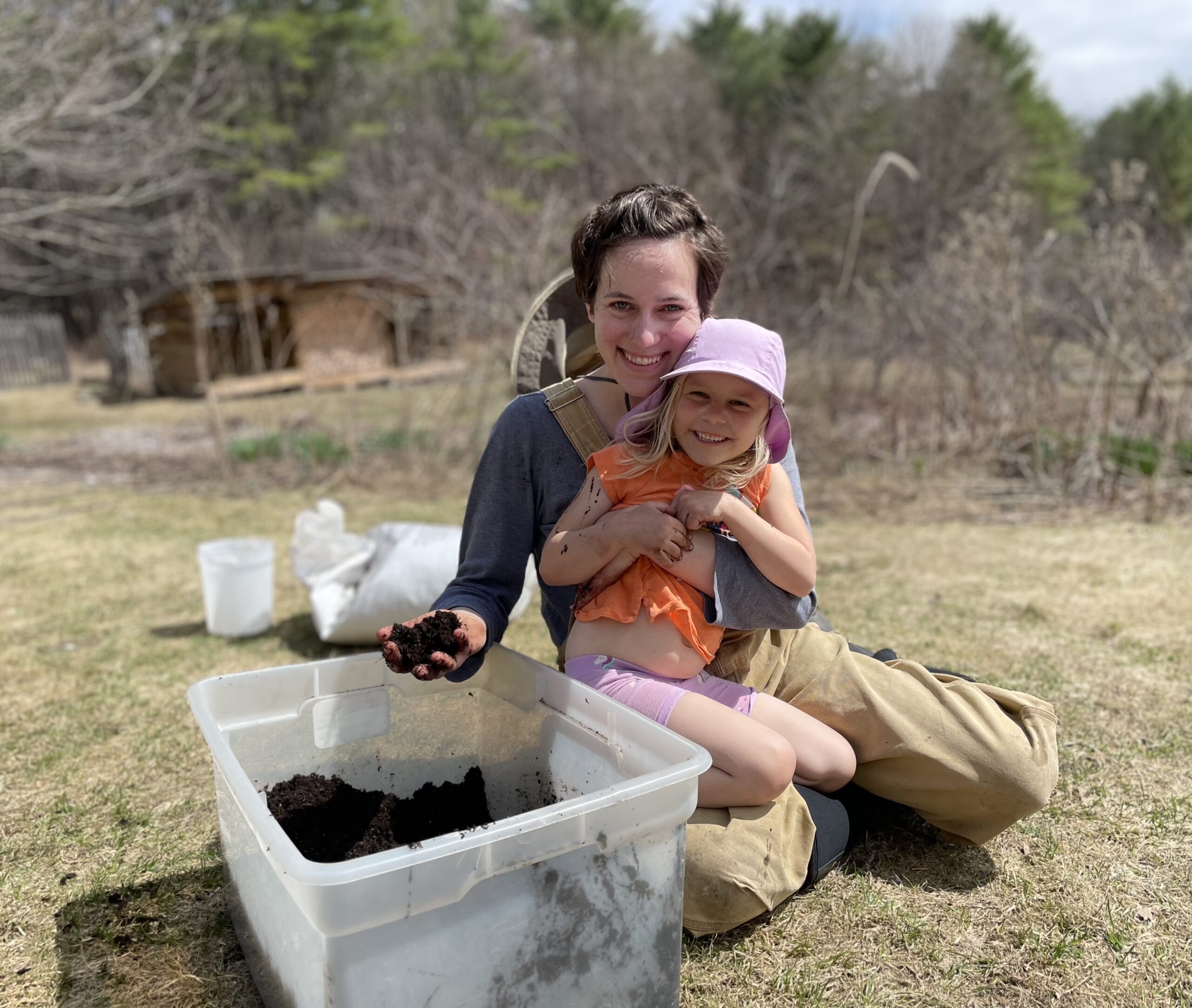
One of the driving forces behind the birth of Frugalwoods was our desire to leave the city and buy a homestead in the woods. That happened in May 2016 and let me tell you, we had A LOT of preconceived notions about what it would be like to live rurally, some of which turned out to be true and some of which… not so much. It’s easy to gloss over the specifics when you’re dreaming about moving to the country. It becomes very much about the specifics when you lose power and water for a week in the dead of winter thanks to an ice storm. It’s those specifics–those powerful details–that have shaped our lives out here.
A gargantuan assumption was that we’d grow all of our own food.
Before so much as starting a single tomato plant, I nurtured an idyllic vision of us growing all the fruits and vegetables we could ever want each summer. There I was among the rows, singing to each vegetable, encouraging it to flourish. Then I saw us in the kitchen–with our children gracefully assisting–as we meticulously preserved each harvest for winter. We then pan to us eating from our larder as the snow falls and the woodstove warms us with wood from our land. Little House On the Prairie without the problematic gender roles, hunger, abysmal treatment of indigenous peoples, and lack of antibiotics and modern medicine!
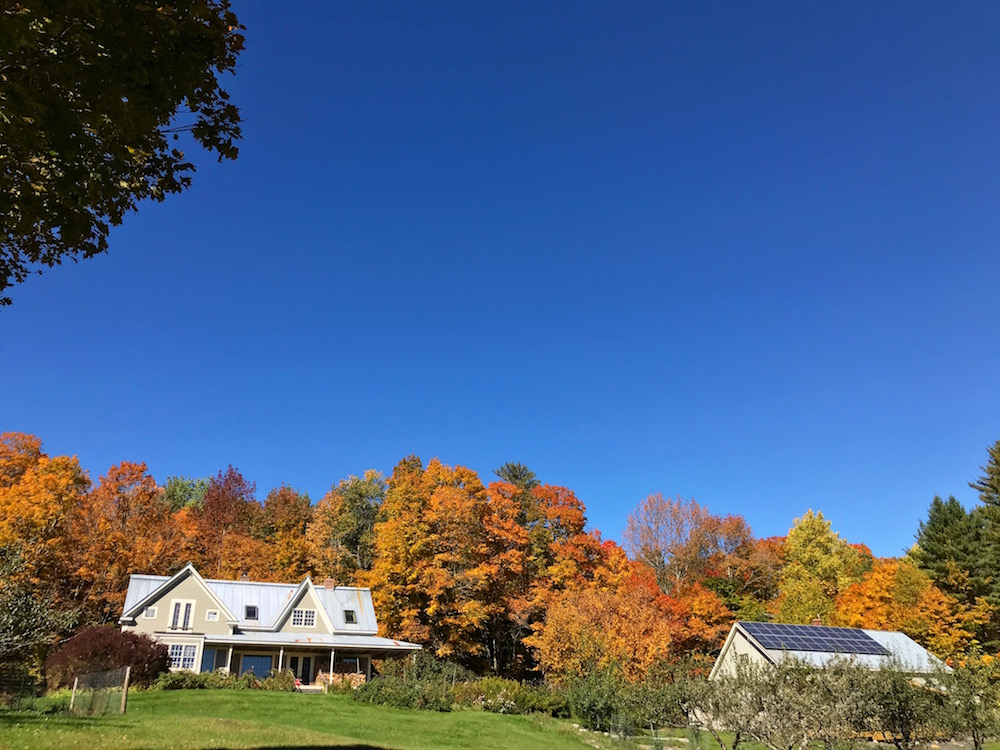
I have a powerful imagination and in addition to growing fruits and vegetables, I thought perhaps we’d raise meat chickens, pigs, goats–why not!–and have a dairy cow for milk from which I’d church my own butter and make my own cheese. Surely we could provide for all of our needs and live out a modern-day sustainable, free range, organic paradise of our own making. To be clear, all of this IS technically possible. And yes, plenty of folks do it.
However, I am not destined to be one of those folks.
My husband Nate and I moved to our 66-acre homestead in the woods of rural Vermont on May 18, 2016 and today, seven years on, I want to share what we’ve learned, re-learned and are still learning about growing our own food. I’ll share more of our rural assumptions in upcoming posts, which are all part of a series on…
Old Me vs. Current Me: A Showdown
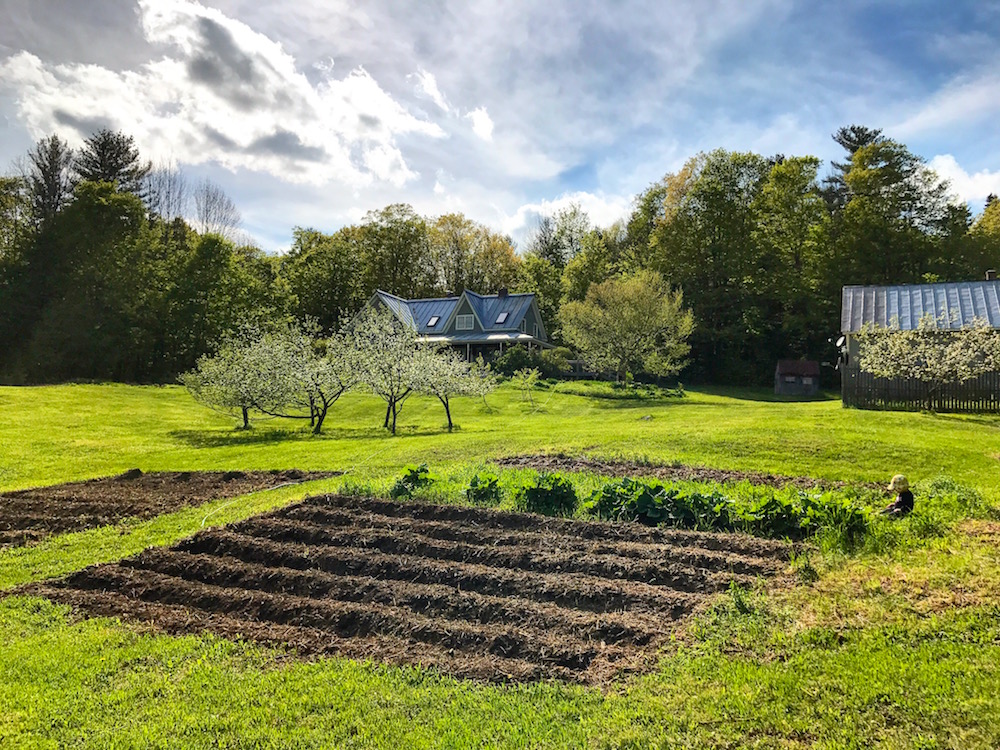
April was the NINTH anniversary of Frugalwoods and to celebrate, I’m typing down memory lane with reflections on some of my most influential old posts. Nine years is a long time to do anything and I’m curious to see if I agree with my old self or if my thoughts have changed in the intervening years. Since May is the SEVENTH anniversary of our transition to rural life, this seems the perfect time to reflect on rural.
You can check out my first three Frugalwoods nine-year retrospectives here:
- Reflecting on Nine Years of Frugalwoods
- Revisiting My 2015 Beauty Manifesto: What I Got Right, What I Got Wrong
- An Update On How Postpartum Depression Changed My Life
Now let’s get to debunking!
Rural Assumption #1: We’ll Grow and Raise All of Our Own Food!
Fact Check: That’s a nope.
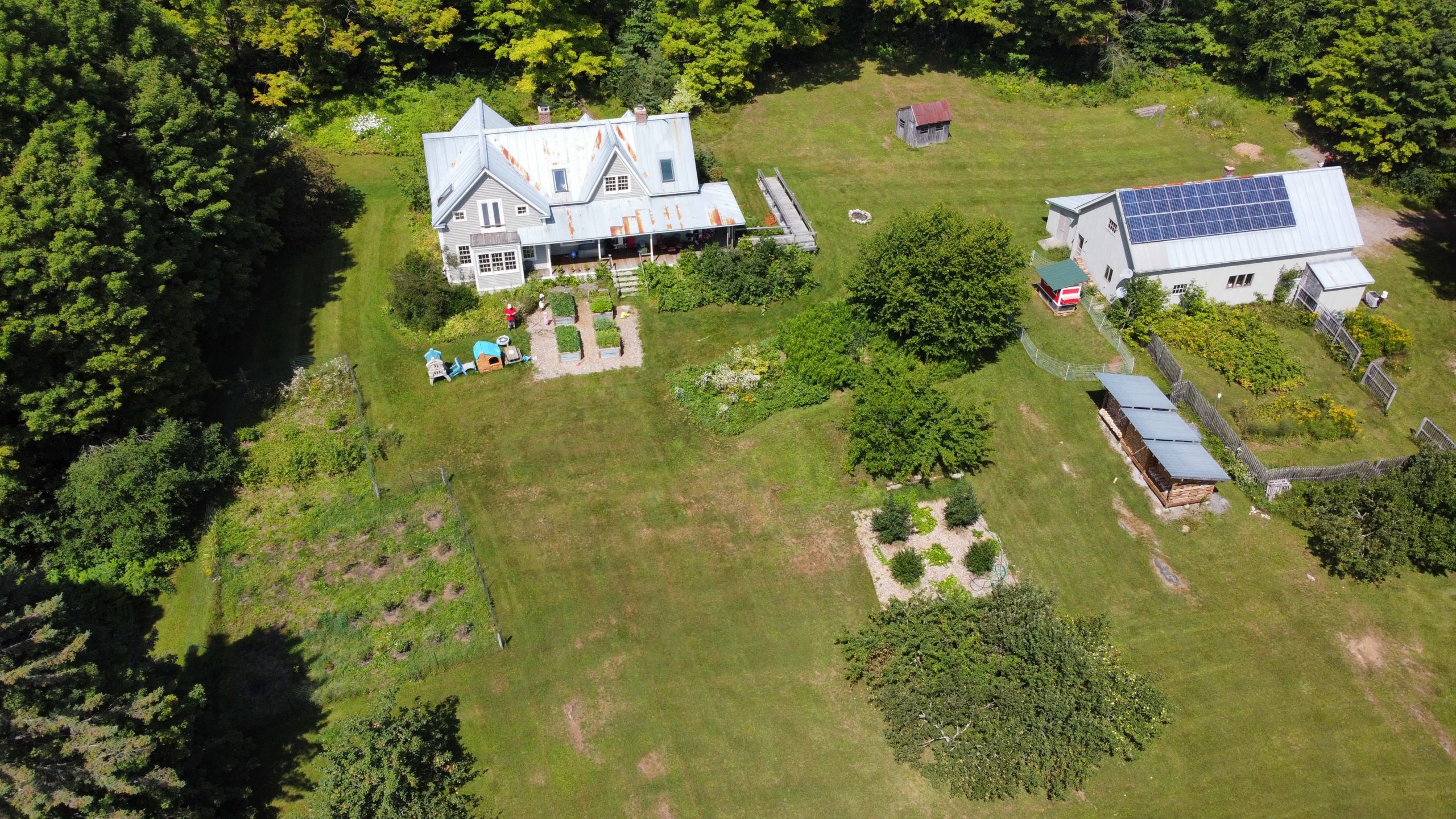
The primary reason? This is an all-consuming, full-time job during harvest seasons and I do not want to grow, harvest and preserve food full-time.
I like to do a little bit of a lot of different things, and that includes some gardening and some canning and preserving.
To accept this, I had to let go of the image of myself as a perfect homesteader out here homesteading away. It’s just not who I am. I like what we do on our land, but I don’t want to do it all day, every day. After seven years, I finally no longer feel guilty for not growing and raising all of our food. I actually feel good about buying food from our farmer neighbors who commit to this work full-time. I like supporting their efforts. Plus, they’re a lot better at it than me.
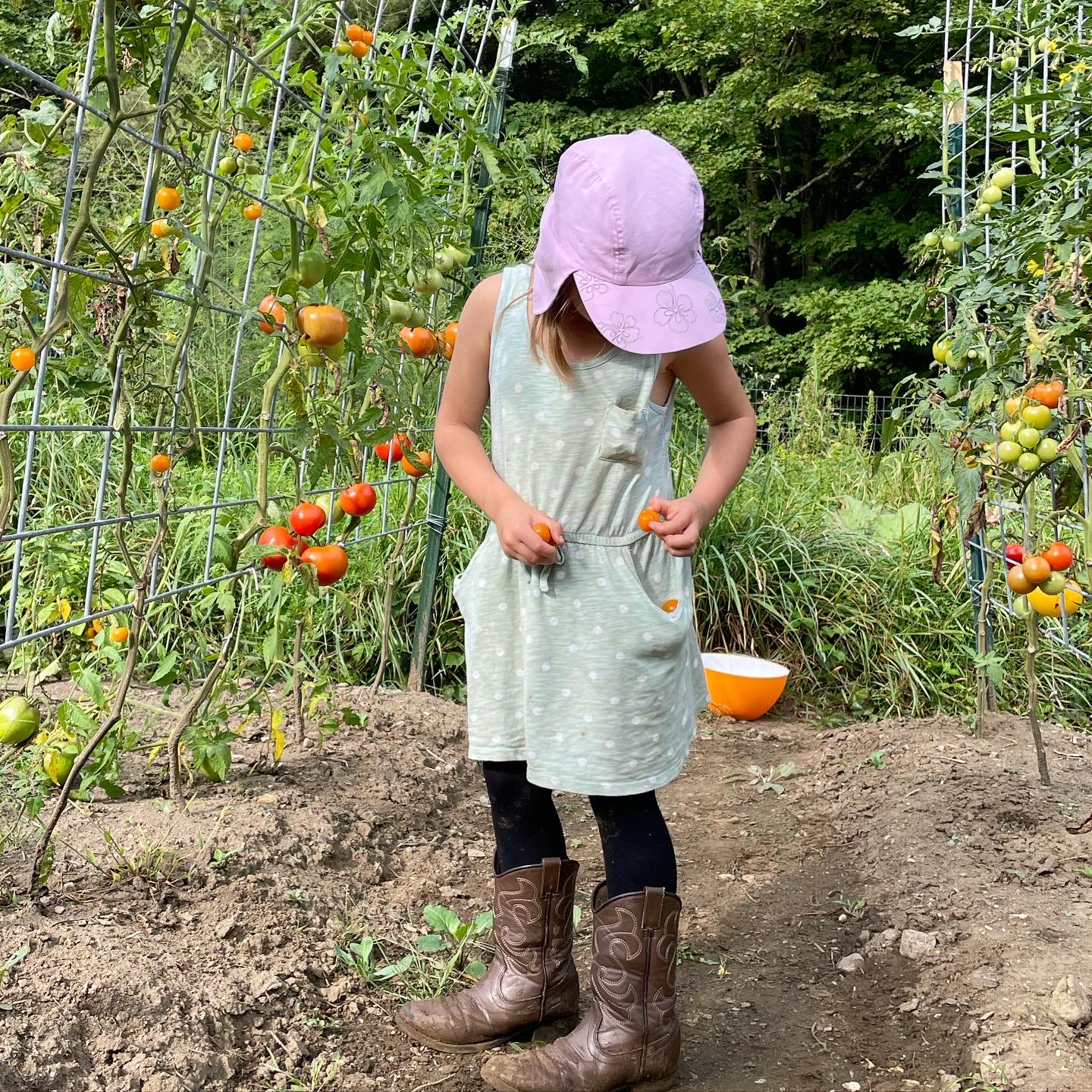
For Nate and me, the whole point of this lifestyle change was to let go of the city rat race, the external pressures and the societal expectations.
We wanted to no longer work for other people and no longer constantly rush around. Rural life, for us, means joy, time, freedom and space. And here’s the thing:
I’ve learned that chaining myself to my vegetable garden is really no different than chaining myself to my desk and computer.
A garden has endless needs, does not care about your time/energy/plans and exerts a lot of time-bound pressures. Anything that saps all my time and energy–and demands I do things I don’t have the desire to do–isn’t why I moved here. Excessive gardening stressed me out. So now, we grow a little bit of this and a tidbit of that and we call it a day. Let me tell you the story of how I got here.
The Kale & Chard Apocalypse of 2018
Detailed in this old post, this was the harvest that did me in. Still early in our gardening experiments, Nate started from seed, planted, weeded, watered and harvested 80 kale and chard plants. Yes, EIGHTY.
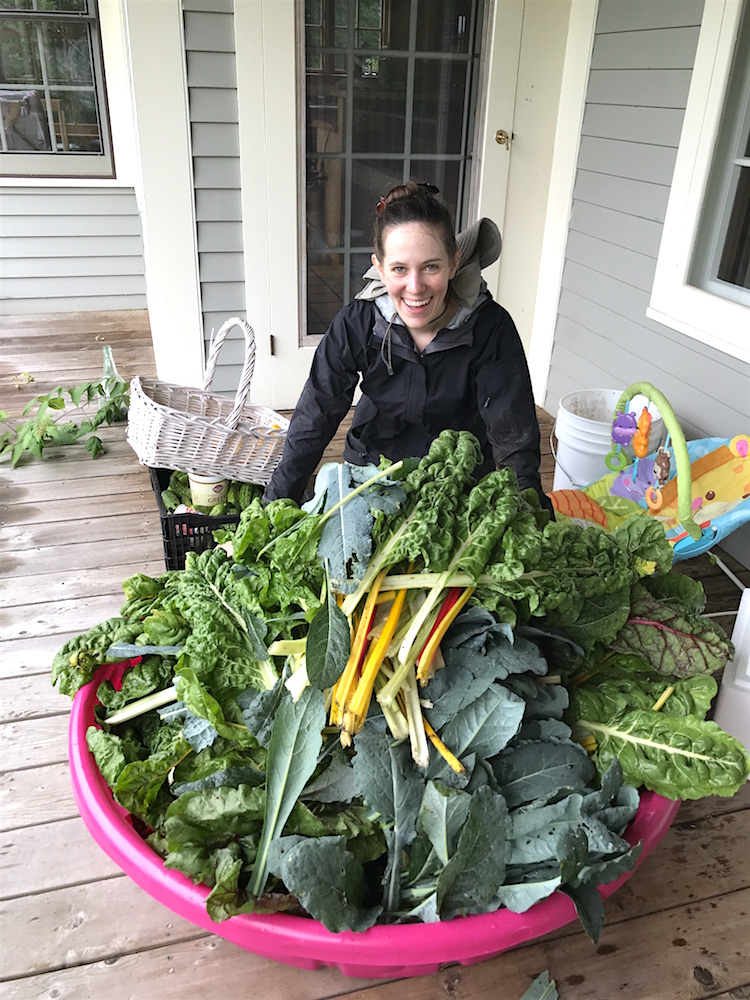
That was 70 plants too many. Because let me tell you: that kale and chard LOVED growing here. It was the most successful thing we’ve ever planted. All 80 of them.
Still under the delusion that I was perhaps actually Laura Ingalls Wilder reincarnated, I was determined to preserve and save EVERY LAST STALK of kale and chard we grew. I wanted to see if we could do it–actually provide for all of our sustenance needs (insofar as kale and chard are concerned).
I spent hours harvesting, washing and drying these greens. The leaves were so enormous that I had to use our baby pool and several giant plastic tubs for rinsing stations. My poor parents made the mistake of coming for a visit during this debacle and got roped into helping (sorry again about that, mom and dad!). When stuff comes ripe, there are never enough hands to help. But you never know quite when that ripe day will be, which means you live at the whims of the garden.
After we’d harvested, washed and (kinda) dried the leaves, we took them into the kitchen for processing, which entailed:
- Chopping them up
- Blanching them to freeze
- OR canning them in a hot water bath canner
- OR turning them into kimchi
And we did it. It took DAYS. A plural number of days. While there were fun moments, it was stressful to do with two tiny kids underfoot. I was exhausted from bending over to harvest in the garden and stooping to wash and standing in the kitchen for hours to process. And that was just to process ONE crop. More precisely: ONE harvest of ONE crop.
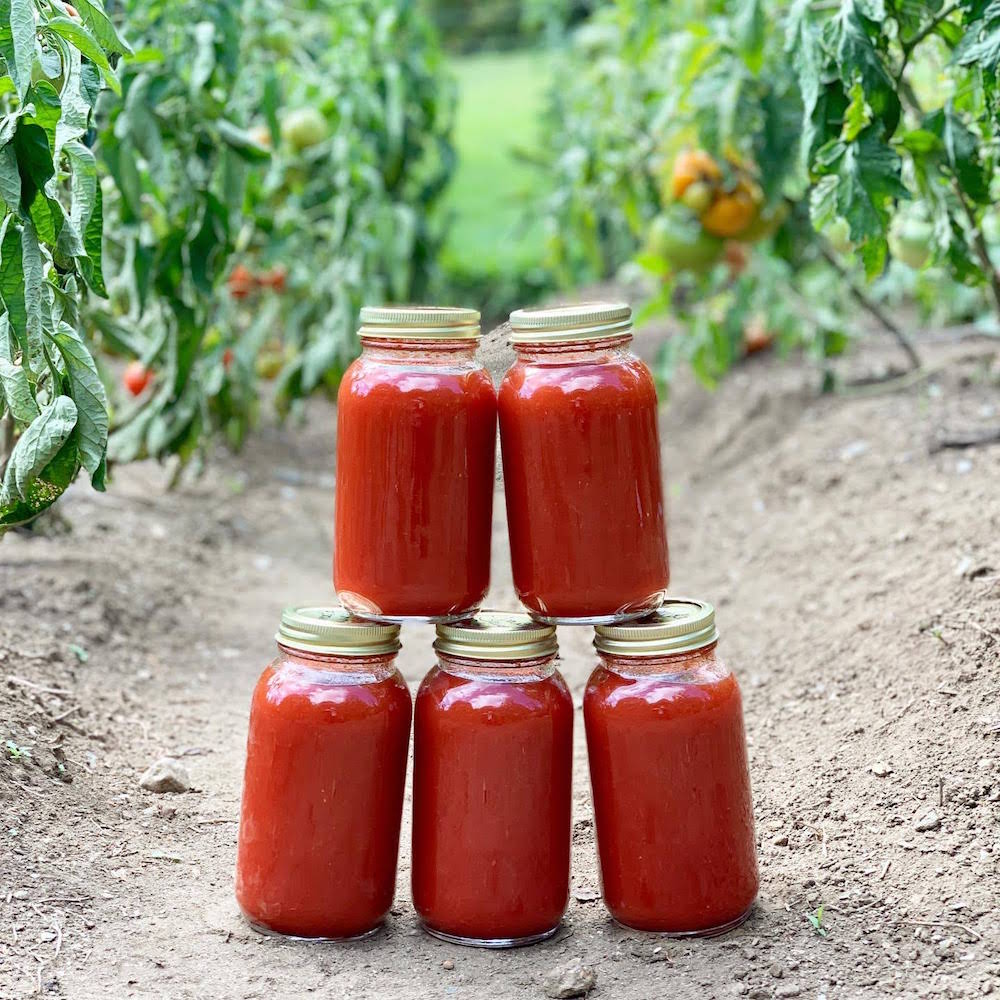
The absolute worst part of it is that we didn’t have a chance to eat all of that hard-won preservation before some of it went bad.
Broke my heart to dump it out into the compost, but alas, home-canned stuff doesn’t last forever and I didn’t know how to calculate our consumption rate.
After that draining experience and the demoralizing realization that we couldn’t even consume all that we’d worked so hard to put away, I decided to change our homesteading food outlook. We are profoundly privileged that we’re not subsistence farmers. We do not have to do this to ourselves. I was competing against an idyllic image I had of people who homestead and grow their own food. I’d read the blogs and books and Instagram posts and I felt pressure to live up to that standard.
I’d succeeded in transplanting the stress and anxiety of my office job onto my gardening.
I needed to change this outlook or I’d soon start to hate what I’d worked so hard to enable myself to do.
Where We’ve Landed In 2023
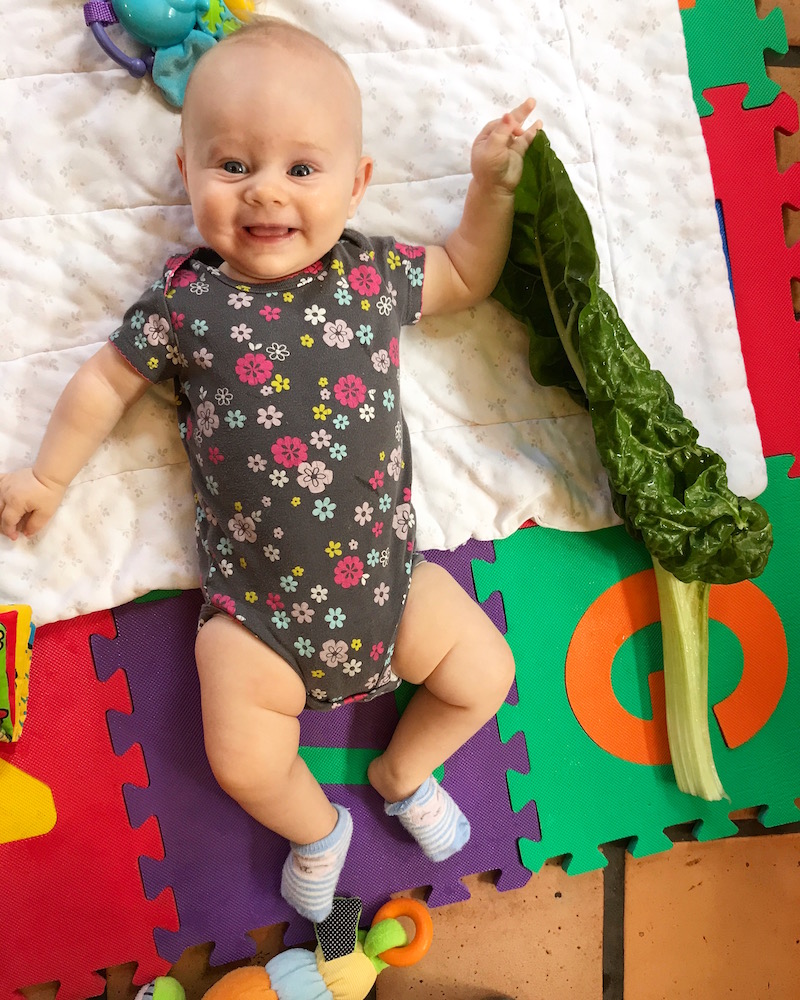
It’s taken years and I’m still working to divorce myself from the self-imposed pressure to be a perfect homesteader. But I’m now a lot more realistic about how I want to spend my time during the summer months. I don’t want to be tethered to the garden. I want to take the kids to the local lake with friends, I want to go hear live music at our neighbors’ farm, I want to hike and play. I don’t want to spend 12 hours chopping and blanching enormous stalks of chard. I want balance and freedom in my life.
Many of you have asked me to re-start my This Month On The Homestead series and to be honest, I haven’t because I feel like we’re letting you down as homesteaders! We did SO MUCH work our first few years and now, we kinda just rinse and repeat with each season. The infrastructure set-up of our first years was staggering and I’m glad it’s over with. I certainly could re-start the series and let you know how things are going, but don’t hold your collective breaths.
Gardening Areas as of May 2023
We still garden and we still have a bunch of different food-growing areas around the property, so I’ll detail each. I did an exhaustive overview a few years ago in This Month On The Homestead: The Full Garden Rundown Including Building Raised Beds. If you’re a garden nerd and want to nerd out, that post’s for you!
Here’s where we plant food these days:
1) Four raised beds right next to our back porch.
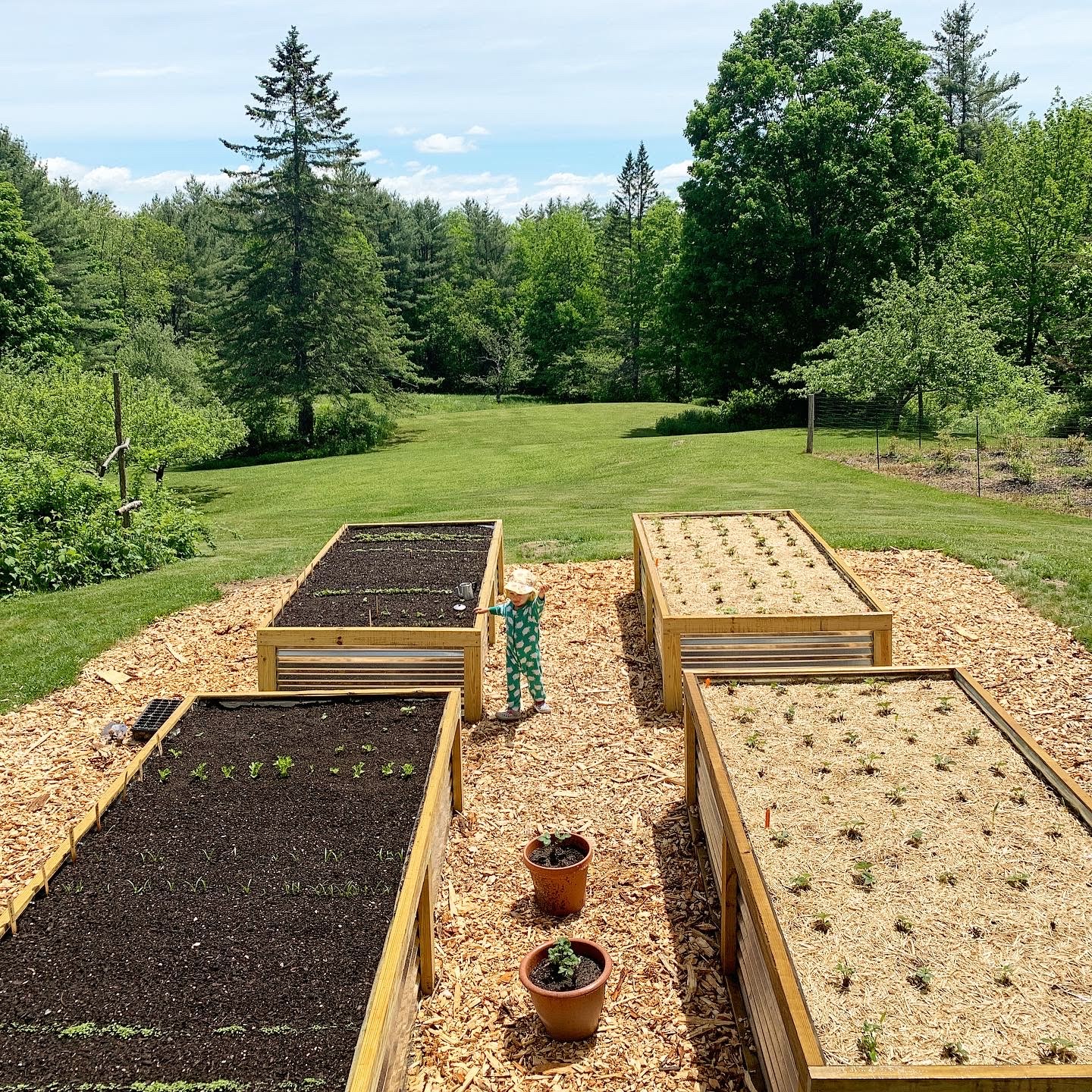
Nate built these back in 2020 and I love them because of their proximity to the house. Easy to walk out and snip a few things for dinner. Here’s what we’ve done with them:
Beds 1 and 2: Strawberries
- We planted 100 strawberry plants back in 2020 and I can’t say that was the best idea. The strawberries attract every type of pestilence, including but not limited to:
- An extended family of garden snakes who tunnel ‘neath the roots and pop their little headsies up anytime I’m out there weeding or harvesting. I don’t mind snakes, but I’d prefer they not POP up at me. A more gradual approach would be appreciated.
- An entire daycare of baby chipmunks who are a hot mess in there. Stomping on plants, rummaging around in the dirt. Mess.
- BIRDS. Allll the birds. We put hooped netting over the plants, but the chipmunk daycare class knocked them over and ate holes in the nets.
- Our own children. So desirous of fresh strawberries that they continually, routinely, annually pluck pre-ripe berries, rip plants and destroy my clever netting system.
-
Making our own apple cider with Kidwoods at the crank Also, since these are raised beds, the soil level sinks each year. We put a ton of logs in the bottom to build up the base, but as those decompose, you really need to add more soil every year, which we can’t do with the strawberries in there unless we replant all 100 of them.
- This year, I turned one of these beds over to Kidwoods, who was begging for her very own flower garden. Half of the strawberry plants in there were dead and I helped her transplant the surviving strawberries into one half of the bed and she planted flower seeds in the other half.
- TBD what I’ll do with the other bed, which is still full of strawberries (and snake tunnels).
Beds 3 and 4: herbs and greens
- This is where I put our herbs: basil, thyme, rosemary, dill and oregano.
- As well as our salad greens: lettuce, greens mix, sorrel, arugula.
- I start the herbs and lettuce from seed and I direct sow the rest.
- The greens can be succession planted, meaning I rip them out when they start to flower and plant new seeds. If I keep up with it, we have fresh greens all summer long.
- I started carrots in here a few years ago, but accidentally put them right next to the dill plant and–wouldn’t you know it–carrot leaves and dill look ALMOST IDENTICAL. There were some casualties.
- This system seems to work pretty well since most of this stuff is annual and not perennial. We added more soil last year and will need to add more again next year.
2) The “Big” Vegetable Garden
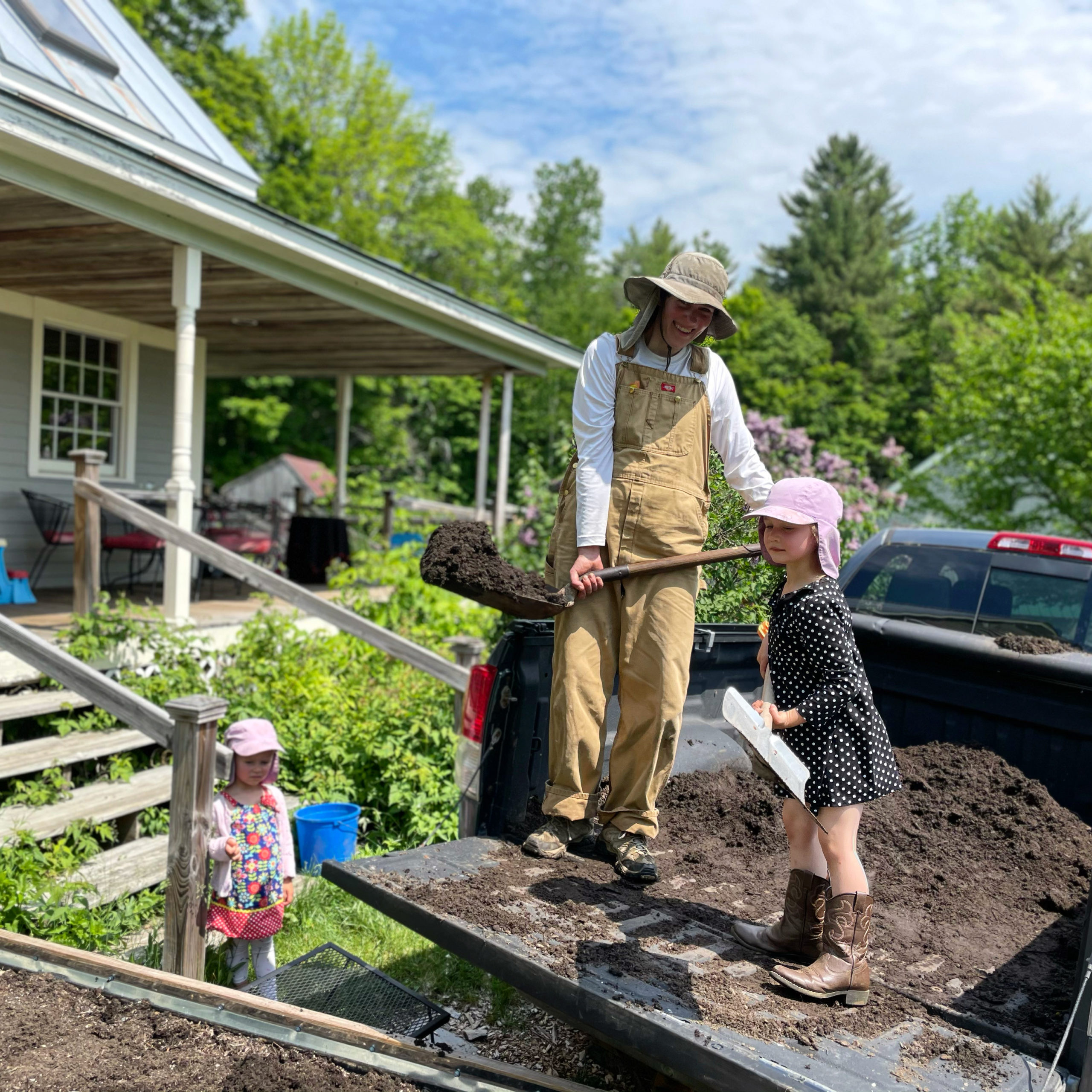
The “big” vegetable garden is where we grow the majority of our annual veggies. Annual means you have to plant new ones every year as opposed to plants that are perennial, which means they come back every year. This garden is fenced in and has cattle panels–which I installed by myself one year, might I add–for things like tomatoes and snap peas to vine up. Much easier than trellising each individual plant. I gently bend the fronds up towards the panels and they take it from there. Highly recommend.
In this garden, we grow a fairly large number of vegetables every summer and love eating fresh tomatoes, beans, squash, snap peas, cucumbers, peppers, and other misc plants I’m now forgetting. I also adore growing pumpkins and gourds for fall decorations, which I feed to our chickens when the season’s over.
This is the garden where the kids each get their own row to plant, tend and harvest!
- Each kid gets to start her own seeds. Whatever seeds she wants! We put them in their own little seed starting trays and–upon Kidwoods’ insistence–label them by name. My trays say “Mama.”
- I start about three trays worth of plants and I only do a few of each kind. I am well aware that we don’t need 89 tomato plants (like I did a few years ago… ).
- We start all of these from seeds in the spring and plant the starts in the ground in early June–too cold to do so before then!
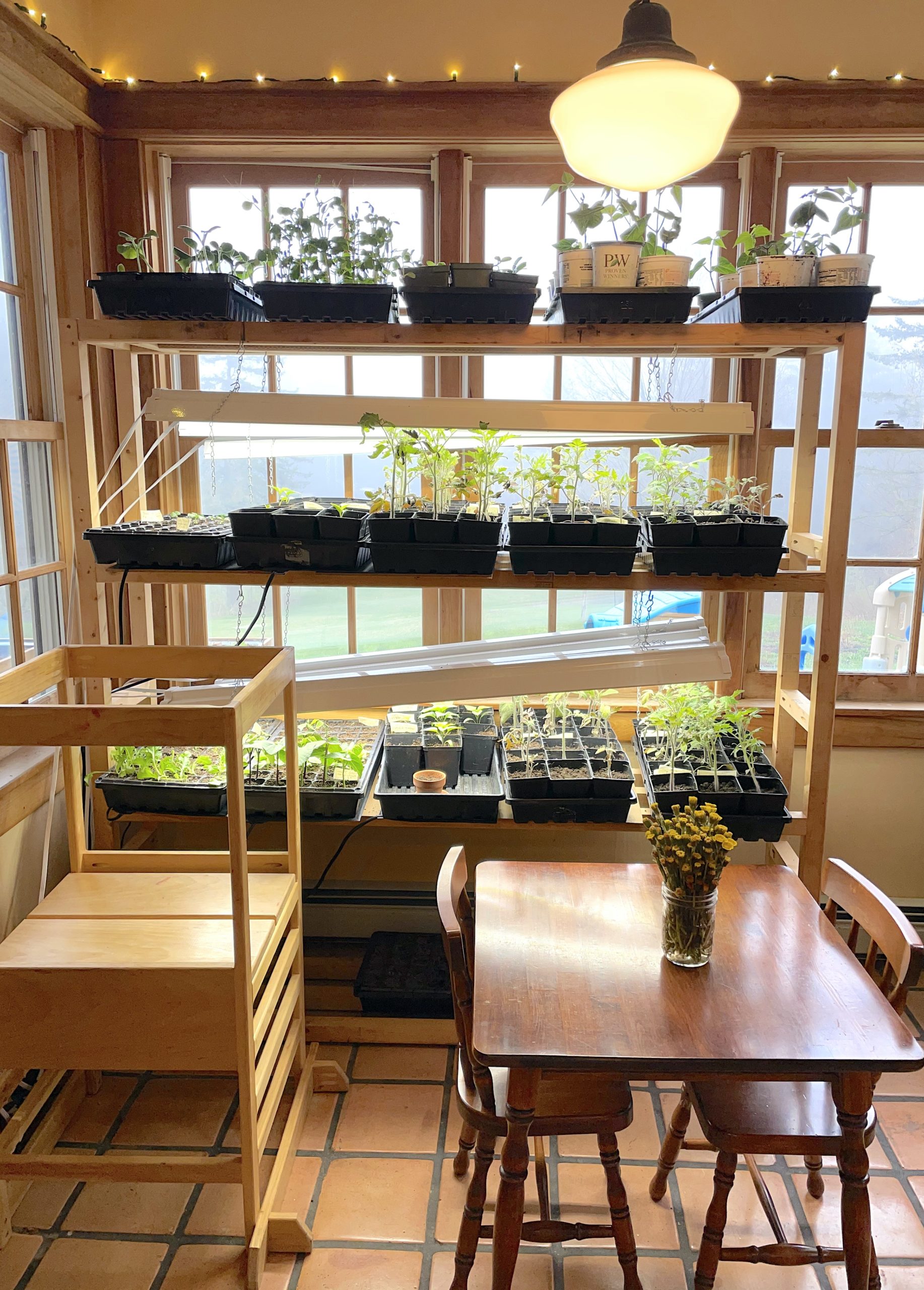
3) Mr. FW tends our perennial food situation, which he’s grown to include:
- 28 blueberry bushes
- 3 currant bushes
- 3 Saskatoon berry bushes
- 3 plum trees
- 4 cherry bushes
- 10 apple trees
- 4 cider apple trees
- 5 pear trees
- 2 peach trees
- 4 elderberry bushes
I’ll admit that sounds like a lot. And in terms of sheer number of plants, it is a lot, but in terms of how much fruit we actually get? It’s not all that much.
Here’s Why:
1. All of this stuff takes many years to ramp up to its full production potential.
It takes an apple tree ~6 years before it bears a single apple. The blueberry bushes took two years to make an edible blueberry. Similar timelines are attached to all of these perennial fruits.
2. Other things like to eat these sweet treats too.
And by “other,” I am indeed referring to the Clever Varmint Patrol (CVP) who, so far, have managed to eat EVERY SINGLE plum and cherry we’ve ever grown. They stalk these plants and then, I swear, the minute the fruit turns perfectly ripe, they snatch it all and take it to their lair(s). We don’t want to use pesticides, building a fence is too expensive (and would ruin the view)–plus a mere fence is no match for the CVP–and we’ve tried netting and chicken-wire cages. We will try netting again, but all that seems to happen with the netting is that our children get tangled up in it…
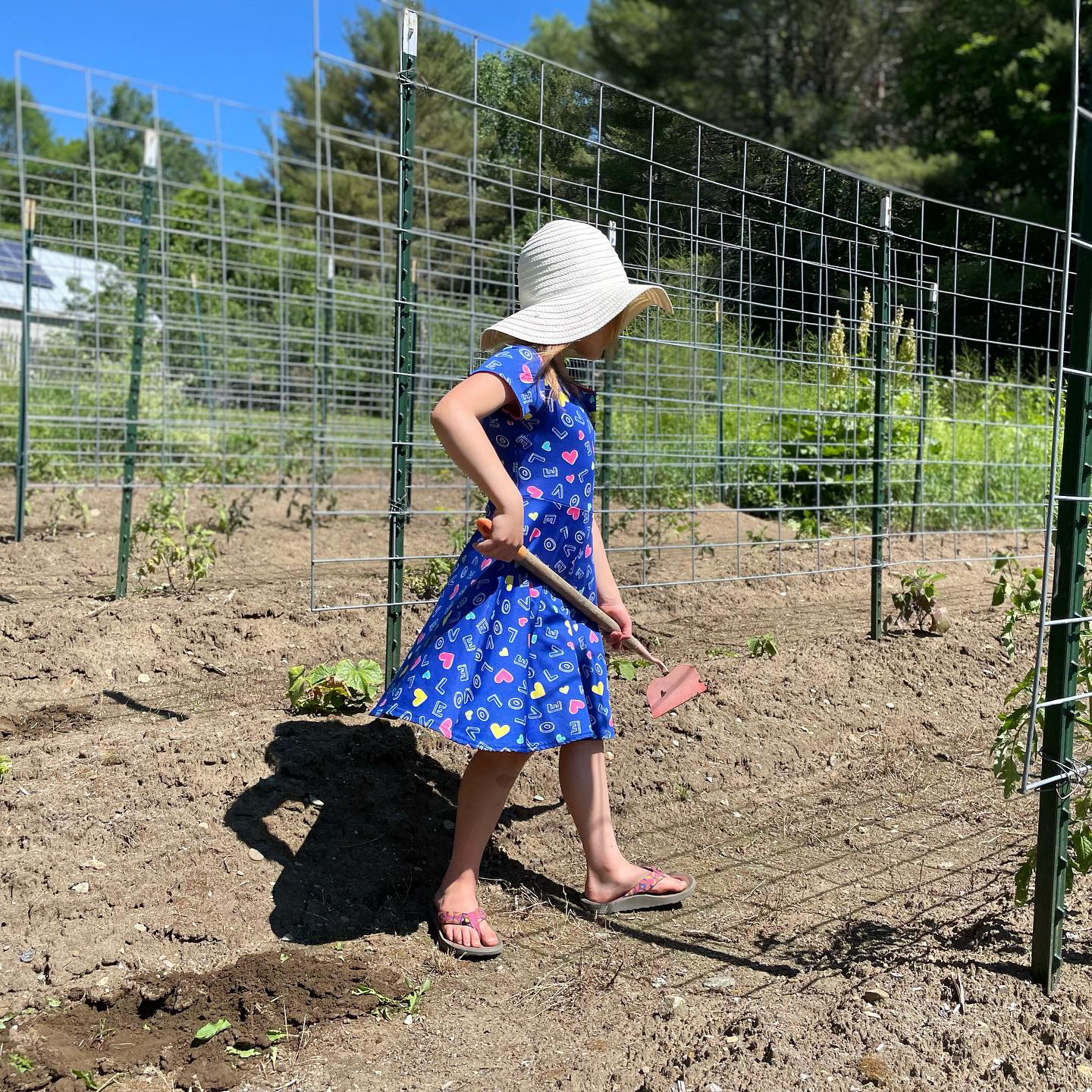
Additionally, a flock of wild turkeys once flew into our blueberry patch–which is enclosed by a fence–and then COULD NOT GET BACK OUT. They’d trapped themselves so thoroughly that when we went to shoo them away, they repeatedly RAN INTO THE FENCE. Nate had to go inside the fence and herd them out. I just… what is there to say about flight-enabled birds who forget how to fly in moments of crisis?
3. The weather, am I right?
If the CVP doesn’t devour them, it’s highly possible these fruits’ll die/underproduce due to too much sun, too little sun, too much rain, too little rain, a late frost, an early frost, a too-cold frost, a not-cold-enough frost…
4. Then, harvesting happens all at once!
Most of these perennial fruits come ripe all at the same time. In other words, all the apples on one tree turn ripe on the same day. And once the fruit ripens, you’ve got to pick it ASAP. If you don’t, the CVP will eat it or it’ll fall to the ground and be consumed by ants and other ground-hugging creatures. Fruit trees, much like children, have no interest or concern for your schedule. They ripen when they want, how they want. If you’re not ready to drop everything and harvest all day long? The CVP will take care of it for you.
5. Preserving! Canning! Pressing! Oh My!
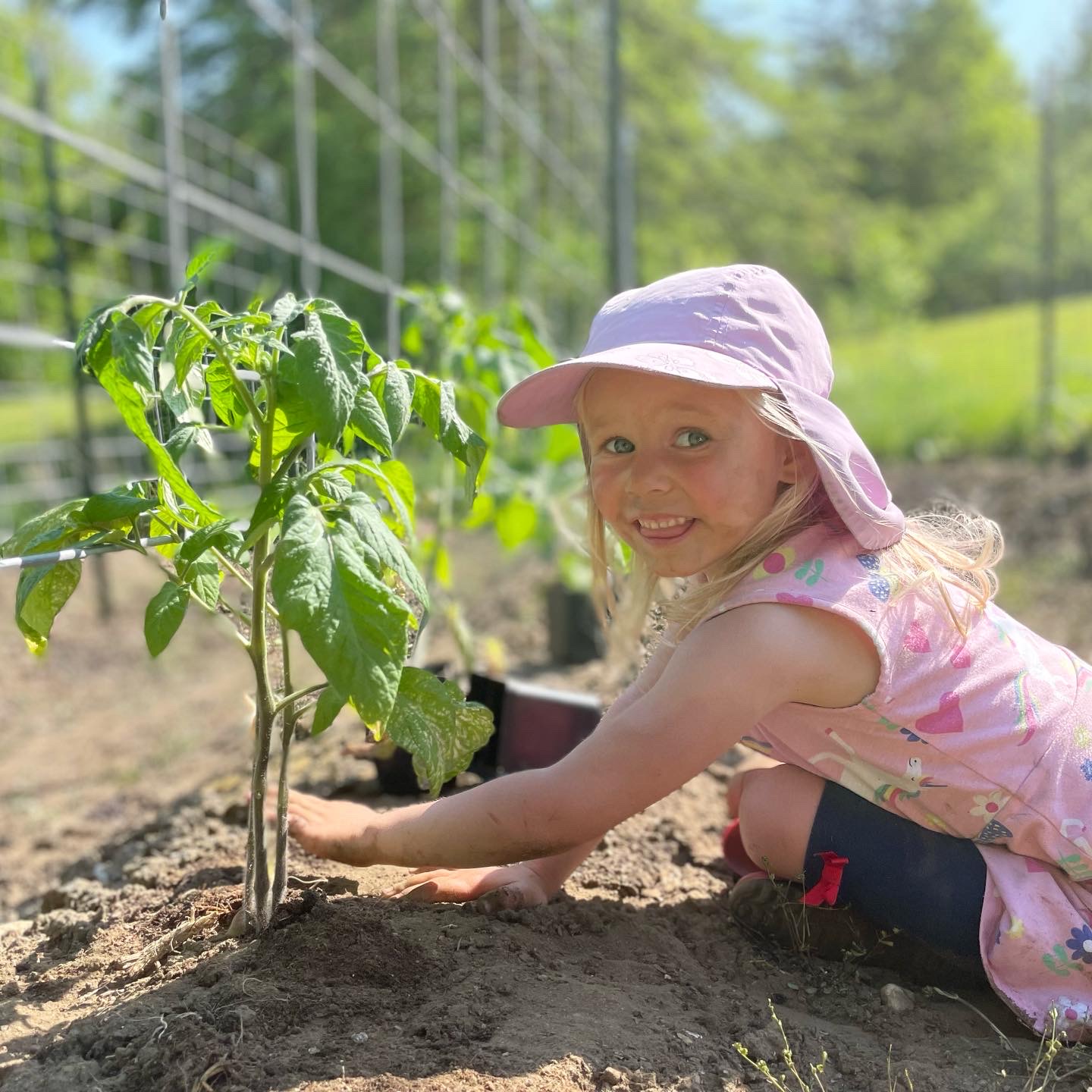
If we are lucky enough to come this far, if a winter frost didn’t kill the plants, a late frost didn’t burn the blossoms, the CVP didn’t exact its revenge, insects didn’t disease the tree AND we managed to harvest all of the fruit on that one, perfect, magical, glorious day… NOW WHAT?!!!
This, my friends, is how I’ve found myself with a kitchen bursting with ripe fruits and vegetables. With so much chard and kale I had to store it in the kids’ plastic pool. With so many apples–all at once!–that I can’t fit all the barrels in the kitchen and have to lug some down to the basement.
It is an incredible privilege to have all this food, but without an industrial kitchen and a work crew and endless time… it doesn’t all get preserved. THOUGH I HAVE TRIED. That kale/chard harvest was the defining moment that changed my mind about how deeply I want to commit to food preservation. Now, I do what I can.
I no longer feel guilt over not turning Every. Single. Cucumber into pickles. We eat a ton, we give a bunch away to friends and neighbors and maybe I make a few jars of pickles. But not 100 quarts. I did that a few years ago and just, wow. People asked me to please cease giving them jars of pickles as gifts. There is such a thing as over-gifting your preserved foods. Ask me how I know.
Here’s how I now preserve the perennial foods:
-
The littlest currant picker Blueberries are the easiest because the kids can harvest them on their own–there are no thorns, it’s very obvious when a berry is ripe and the bushes are low to the ground. Then, all I have to do is rinse them and throw them into bags in the freezer. Easy.
- Apples are the hardest. Nate or I have to do most of the harvesting because they’re so high up in the trees. That doesn’t stop the kids from helping and they both get beaned on the head by apples every year. Apples are also tough because they require a ton of work to process. I like to make applesauce, apple butter and dried apples, but all three require me to first wash and dry the apples, then peel and core them, then cook them down into sauce or jam, and then hot water bath can the sauce. Repeat this MANY times until you’ve used up all the apples (or they’ve gone bad waiting for you to get to them). We’ve also pressed them into cider in past years–and probably will again in the future–but this is another massive investment in time (not to mention supplies).
- Strawberries get eaten fresh (mostly by the kids, mostly before even making it inside). Easy!
- Plums and cherries get eaten by the CVP.
- Currants are made into jam, which is fairly involved, but we do seem to eat that up and it is worthwhile to make it.
- Nothing else produces fruit yet.
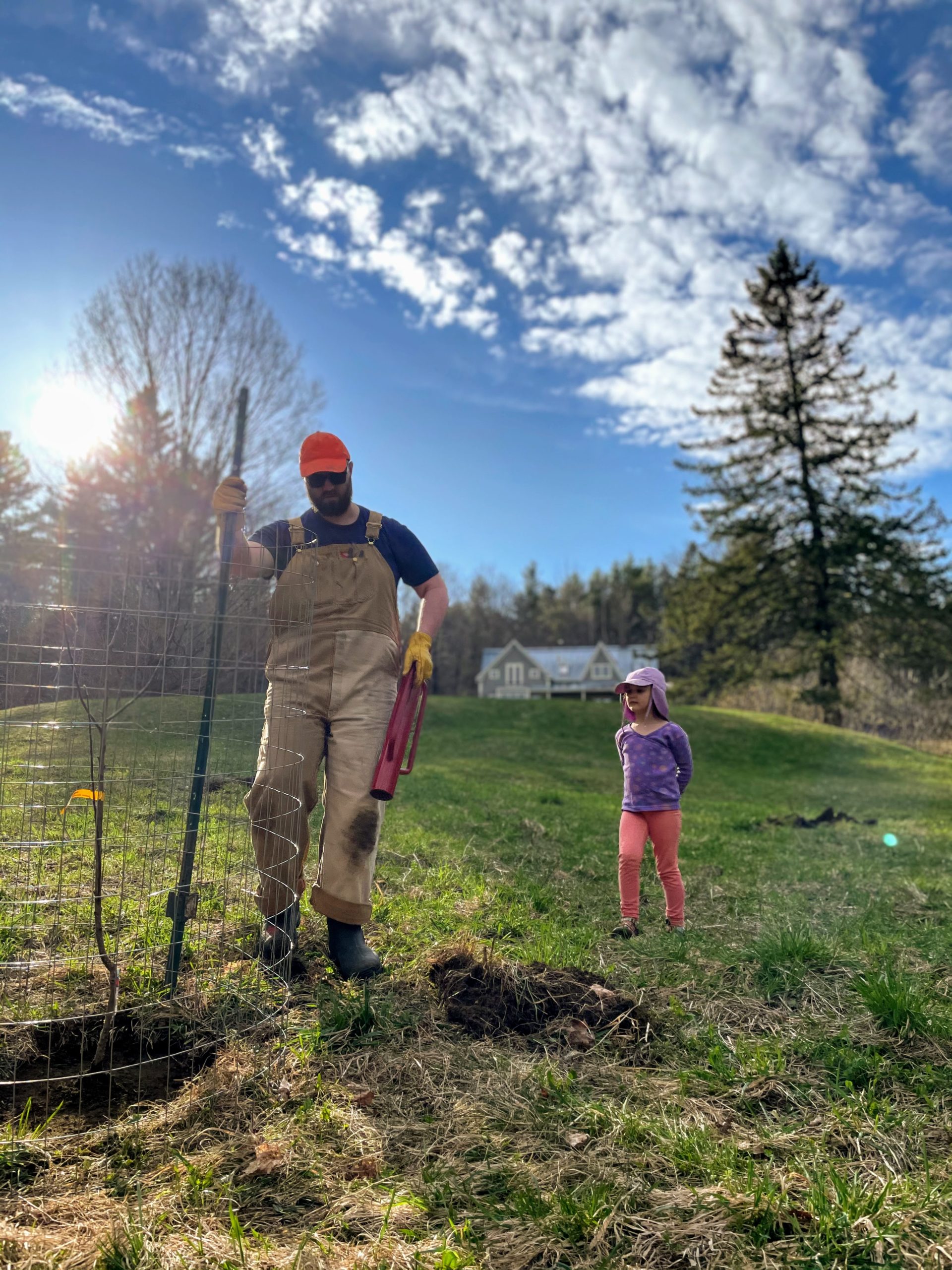
Sometimes we preserve annual foods, including making:
- Tomatoes into sauce
- Cucumber into pickles
- Beans into pickled beans
All of this is fun to do in moderation and we do eat it, but in moderation. Since we don’t have to eat pickled chard stems to survive the winter, we don’t need to make 90 quarts of pickled chard stems. To be clear: many folks choose to grow and preserve all of their food and that is great! Many folks do it successfully and have very low grocery bills because of it! Not me.
Acceptance
The final stage for every gardener: acceptance. Acceptance that I do not like being out in a garden all day OR in a kitchen canning all day. I like to be in a garden for awhile and I don’t mind canning for awhile. I like doing it with the kids since I think it teaches them some nifty skills.
But it’s no longer a race to ultimate homesteader for me. I’ve realized that the pressure for perfection isn’t limited to school or traditional jobs–it can take over anything. Even gardening!!!! So we’ll plant our little plants this year and maybe remember to weed and water them. And I might can a few quarts of apple sauce. Or I might not. And either way? We will still be grateful to live out here.


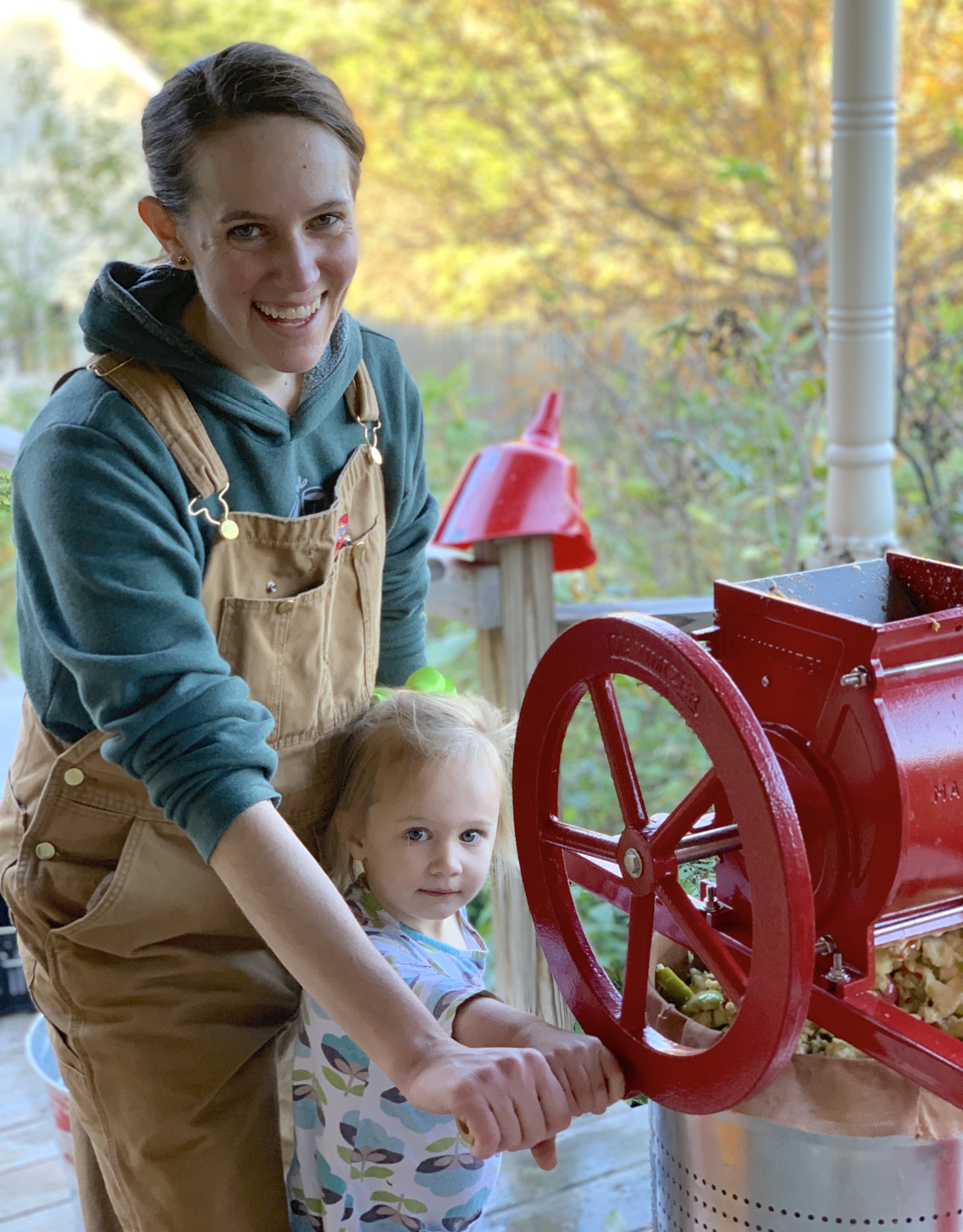
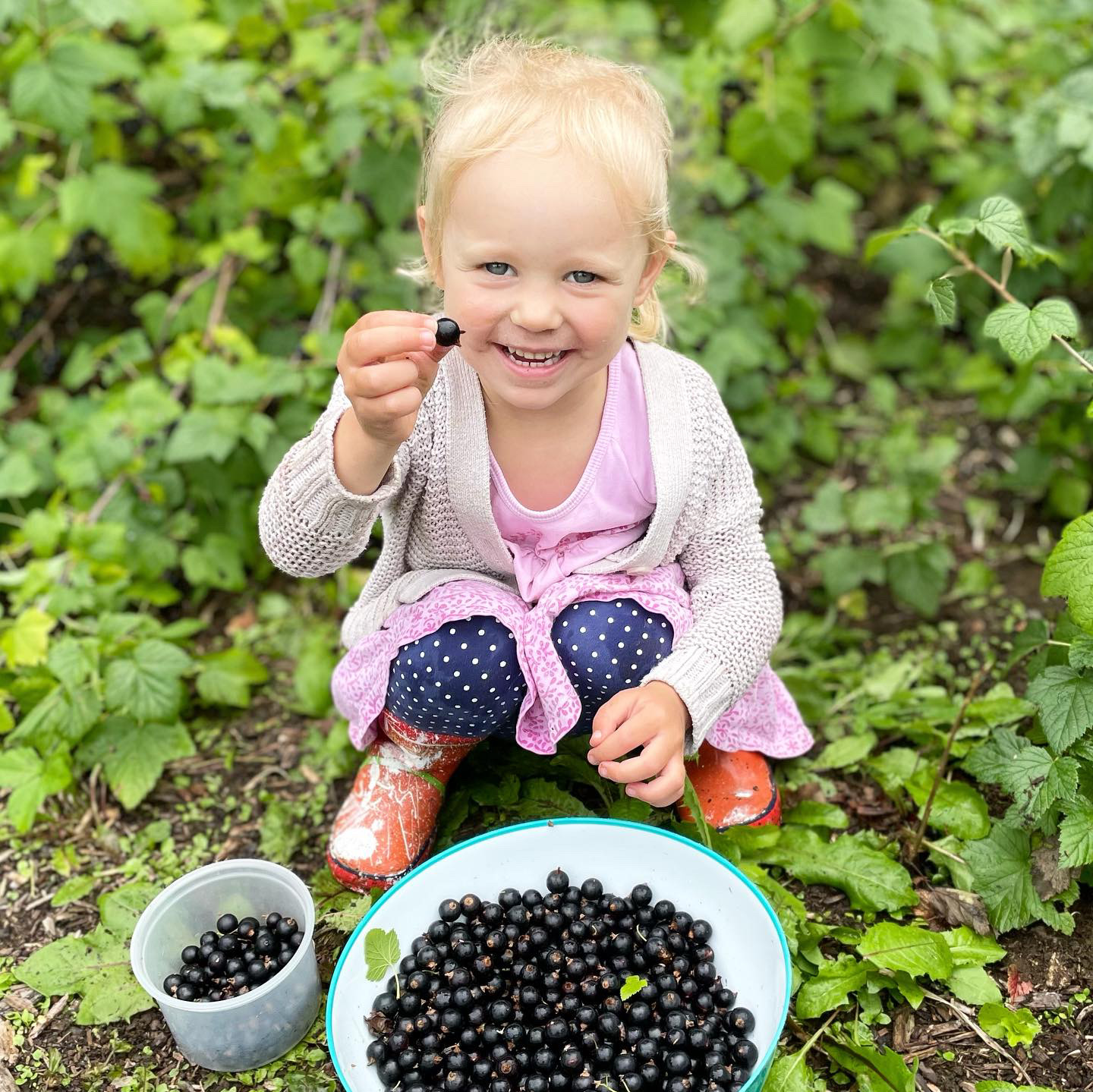
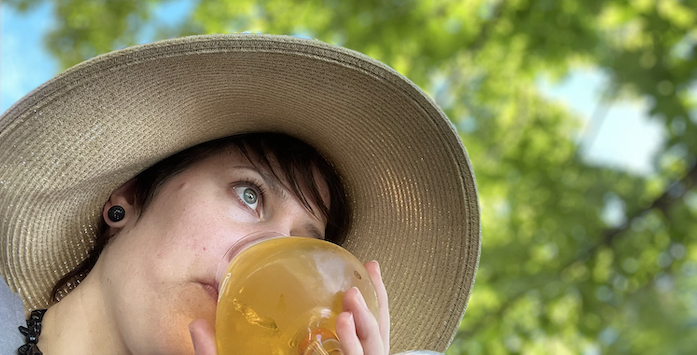

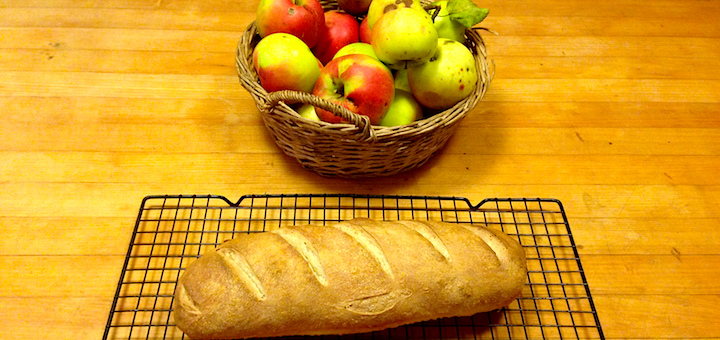
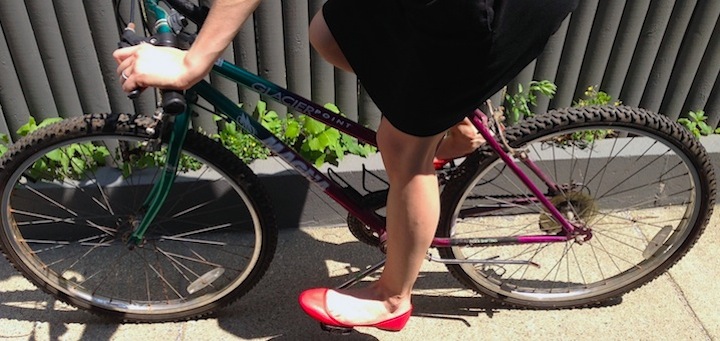
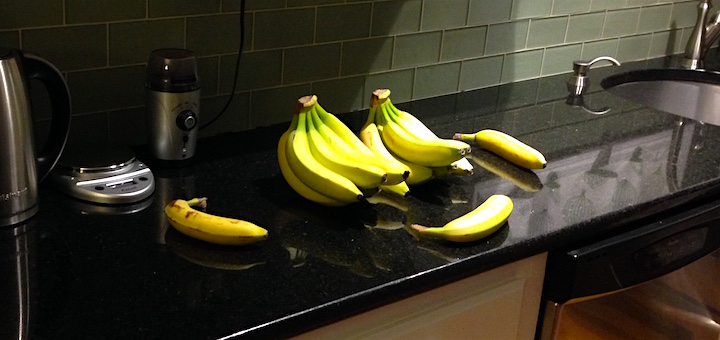
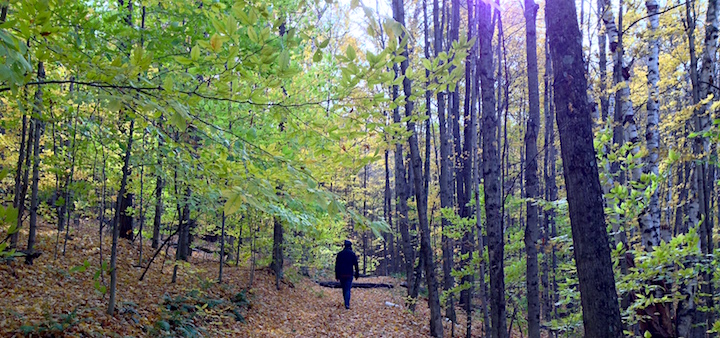
Very much appreciate this. We moved to a smaller plot of land than yours but had similar visions of a permaculture paradise. We do still grown a lot but I also have decided it is just fine for me to pay the lovely berry farmers nearby so I can pick berries to my heart’s content.
What is it about the strawberries anyway? When we first tried we brought our little blackened plants to the nursery and the man looked at us and said “Could be too much sun, not enough sun, too much water, not enough water…”
The bit about excess harvest has me wanting to put in a plug for donating to a local food pantry. Not all take fresh veggies from gardens but we’ve always been able to find an organization locally that would take the excess veggies.
Yes! We absolutely do this when we have an overload 🙂
Best of luck, appreciate the update. As for apples, we love to do “apple compote” – the apples are quartered,cored and caned (similarly to this recipe – https://practicalselfreliance.com/canning-apple-slices/) but we keep big chunks. great for pies or with rice+chicken dinner etc
Thanks for being so real! I admit to harboring a lot of the same fantasies and struggling to make them reality on our little homestead too. I still have quarts of green beans that I pressure canned a decade ago. No one in my house (including me) wants to eat soggy green beans when you can pop in to the grocery store and buy fresh for $1.99! We are definitely chained to a 19th century ideal that doesn’t always work out so well in the 21st century.
“I do what I can.” Best double entendre of the morning 🤣 and also, as a gardener who feels the same, yes to all of this. There’s a limit to how much kale sauerkraut my kids will eat, and it is well south of three dozen jars !
Thank for such a hilarious article – I liked the line about the kids getting tangled in the fencing! I certainly agree that growing all your own food is a utopian dream, but being able to source virtually all your food locally is easily achieved. We do this ourselves (we live in Vermont also) and it is very satisfying to know that we are also supporting local farmers, homesteaders and artists!
I can relate! We have 5 acres and my plan was to homestead as well. I started with the animals and got assorted poultry, bees and goats for dairy. We raised meat birds. I still work a full time and quickly became overwhelmed. It’s also expensive to raise your own food, far more expensive than just buying. I finally said enough when we almost lost a mama goat and her babies to a traumatic delivery (vets are heros) and I decided I want to just have all my pets instead of worrying about my animals being productive. I might still occasionally freshen a goat because the milk is so nice but I also miss the simple days where I could just pick up a gallon at the store when needed. I now laugh when people refer to moving to a homestead as “the simple life” because it’s the least simple life I have ever lived!
I have to respectfully disagree with your statement that raising your own food is far more expensive than just buying. (And I am not speaking about environmentally, when it is better for the earth to raise your own than have it trucked to the grocery store and then driven to your house.) I keep very precise records of how much I spend on growing supplies and then the harvest from each plant. I then price the harvest by what it would cost to buy those same amounts in the grocery store. I have not had one year where I did not save money growing our own, almost every year more than $1000 cheaper. I don’t want to discourage folks who want to save money and think that growing vegetables will help.
I agree. Not to mention, I know exactly how my food was grown.
I am glad in your experience it has been less expensive. In my experience it has been more expensive. Especially when you factor labor costs (mine) and the need to
spend more money on things that save time. I have had the best ROI on gardening but with infrastructure costs and the cost of mine and my husbands labor/time we are still in the red. Animals, especially with the rising cost of feed have cost far more to produce food. I am not trying to discourage people, just saying as someone who’s done it, I can relate to having a homesteading fantasy not work out the way you thought it would.
That sounds amazing – obviously you have managed to make it work and it’s satisfying and a big accomplishment…
It just sounds like a lot of work, and to make it sustainable, i.e. to be enough to feed our family, all the time or nearly all the time, it would involve a level of commitment I don’t possess.
Aside from the money aspect, there is also the security aspect of having some food growing around you, which the recent pandemic highlighted.
This is a great honest description of what you do- thanks! It’s sobering how much time and muscle are required to grow even part of one’s food supply! I gave up on strawberries, too, due to the chipmunk motels in our lovely stone walls. Apples don’t need peeling or any treatment in acids to dry; so sweet to eat from jars in January. I don’t peel for applesauce either, just cutting them up– takes 5 cuts per apple, cutting out the cores, and dumping them in a pot with an inch or 2 of water or cider to cook down. Then I force this through a stainless steel colander. best sauce ever! Tomatoes can be cut up, unpeeled, and roasted on a half sheet with olive oil and sliced garlic( heaven!), then frozen.
Lane, how do you serve those heavenly tomatoes?
When the turkeys that live behind my house fly up into the trees for bedtime, they seem to need a running start. And they barely make it. Not the most graceful creatures.
I was just thinking the other day about how all the new gardeners during the pandemic raved about how they were looking forward to the bountiful harvests their new gardens would bring, while experienced gardeners just smiled and nodded, because – they knew.
I used a Victorio strainer for cooked apples, pumpkin, fresh grapes and fresh tomatoes when we had a big garden (if I could find a deal on apples; they don’t grow so well here so I have to buy them), but now, canning much smaller amounts since the kids are grown and gone, I use a Foley food mill. With either, peeling is unnecessary. Highly recommend.
I fight bugs, tropical storms and fungal diseases every year. Sometimes I get a lot of produce, but usually, I get just some. Once in a while, I get none. It’s always a gamble. Like Mrs. FW, I had ideas of being the perfect homesteader and wore myself out canning and preserving while working full-time. Now – not so much. It sure sounds good, though, doesn’t it? Thanks for the funny and honest post!
Long time reader, first time commenter. 😂 It feels so good reading this post!! We have a 10 acre homestead, and it’s so easy to feel disheartened when I have to pick up eggs at the grocery store (here’s looking at you, slacker hens…). Thank you for the reminder that our homestead is not perfect but we’re still lucky to have it. 🙂
OMG Mrs Frugalwoods you NAILED it!!!! Slam dunk! I forwarded this article to several other friends who were disheartened by the reality of “off the grid” life.
Like you guys we dialed it back no more 20 varieties of pepper plants! We had so many peppers we had to give most of them to the Indian & Chinese restaurants we frequent!
Now we dial it to:
1) enough for us
2) Enough to give away to fave neighbors
3) enough to cover Varmints & weather
I visited a friend with a hobby farm. It crushed my fantasy. But actually it made it better. No cows, no goats.. no pigs…maybe just maybe chickens! ( fortunately we aren’t big on meat and the butchering that goes with it.)
The rest is all annual vegetable gardens= Toms-basil-Bellpeppers ( expensive ones like orange , red & yellow) WE cook up a lot of Tomato sauces and chop up serrano’s in individual packs for winter chilis. For fruit we have thornless blackberries, raspberries, figs, honey berries, and like you guys we are still waiting for Paw Paws and Cherries….
Your article validated our new “victory garden half step” approach to growing our own food. I advise everyone I meet to visit a hobby farm or off the grid sitch to bring one down to the good earth and reality of growing your own food.
I hope earth never takes and asteroid hit! Or we are in trouble! haha…
PS- Love your rows of cattle fencing…. way better than our “tunnels” we bent to create a walk through.
Just curious…. Did you mean “churn” your own butter? Your spelling and grammar are always meticulous, and your humor (Canadian over here and I first wrote “humour”, but then figured that the spelling police would come after me so I changed it) is always on point. Therefore, I’m assuming it was an autocorrect typo 🙃
I actually spent a couple minutes mulling over whether churching butter is actually a thing before posting this.
LOL Laura I saw it too and laughed because Liz never makes mistakes with spelling. It had to be stupid autocorrect.
My parents used to live in your town, Liz, and faced the same issues. We kept telling them to cut their garden size in half and enjoy it more. They did a lot of beans and my Mom finally learned to forget canning and freeze everything. So much better, timewise. Those apples went in the crockpot and then in the freezer….we all loved chunky applesauce (though Mom did use a Foley food mill. I never bothered.)
Liz, you don’t need to apologize….ever….for privilege. You and Nate may not HAVE to do these things, but you have worked endlessly to get to the place where you are and to plan your lives around what’s best for you. Teach the girls, and enjoy. You have earned this lifestyle.
I laughed out loud several times at this post. Thank you for sharing your foibles and your hard-earned self knowledge with me/us!
How does my garden grow? Survival of the fittest around here. *Someday” I will look into what veggies to plant near each other and other specifics that will surely result in better results (and I really DO want to do this someday, but alas, it’s not high on the priority list at the moment). For now, everyone is planted where my brain says it makes sense and we see how it goes. The tomatoes LOVED the spot I chose last year… it was insane how many came from two plants. The bell peppers were tasty, but would have liked more sun as they were on the dinky side. Greens did well until they didn’t and I wondered… why have I never thrown those seeds back in the ground when they bolt? What the heck? I plant in different places each year to see how things go, so I guess you could say I take an experimental approach to gardening which works in my life at the moment!
I laughed through this whole post, because it’s so relatable and true. Homesteading has been majorly romanticized in the last 5 years and I fell prey to it also. I’ve learned that I absolutely hate canning, so I don’t do it anymore. Sounds dumb but one day I just had the realization, “you don’t actually HAVE to do this.” So freeing!
Love this! I like to mess around in my garden but the best time with it is in early spring when it’s all a fantasy 😂. When I was a kid, I was forced to participate in canning sessions at my grandma’s. All my aunts and girl cousins (yep, misogyny) worked for days to cancel stuff that was just as easy to get at the store. It was so hot! And unrewarding. I vowed I’d never do it as an adult! Woo hoo. I’m willing to make refrigerated pickles but that’s it
What a great update, thanks for sharing! A couple of thoughts for you: 1) try no peel applesauce and butter! I stopped peeking and coring apples and it’s life-changing. 2) you may want to rotate your raised beds to make sure the soil has the right nutrients, or your crops may start to get less tasty and plentiful. The easy way to remember is rotating leaves and roots with flowers and fruits, either season to season or year to year.
I made some quarts of no-peel applesauce a few years ago and my kids declared it “inedible.” LOL
You might consider leasing some of your garden space to a local organic farmer in return for cash and/or produce. Let someone else do the hard work and get the benefit of fresh produce and, perhaps, cold cash in return. Your land is an underutilized asset.
There’s a lot to be said for specialization of labor!
I guess growing up in the midwest there was always someone trying to get rid of excess zucchini, and we always had excess apples ourselves (I know so many apple and zucchini recipes), so we already knew this lesson, just with our ex-urban backyard. Re: apples, we would never peel (or dry) and instead of coring we’d do the cut into 4 pieces then remove core method before turning into the apple compote mentioned in another comment. The compote freezes well and becomes instant pie filling (often with rhubarb or raspberries from our garden) or apple sauce. Though my husband’s grandma who had a rural farm had one of those spinny hand-crank things that cores and peels at the same time, so maybe that’s more efficient. Even so, the only thing she canned in large amounts was strawberry jam.
Midwest girl here too. When is the only time country people lock their car doors? during zucchini harvest 😉
That’s the thing. I used to hunt the hedgerows with my dad when the snow was on the ground and the sun was shining.
It’s not a myth that those days seem to make the Cottontails feel secure though they stand out like a sore thumb.
We don’t use firearms rather twenty two pellet rifle.
Even that becomes repugnant as we got older and thought we’d raise our own.
We got, “Rabbit poor” very fast.
If your kids are inclined to name the baby bunnies that’s the end of Rabbit Pot Pie.
Here’s one solution. Grow okra and pickle it with dill. It’s rich in vegetable protein.
Wear gloves when you’re picking it though because there’s a mild irritant in the tops of okra plants.
And don’t give the fruit a chance to get large and woody.
If you doubt the ability of a vegetable diet to produce muscle and bone read HDT’s Walden.
I really enjoyed this. We live in the suburbs yet for 10 or 12 years we kept hens for eggs and I battled with the massive suburban deer population to try to grow vegetables… We also raised a number of large batches of meat chickens and amortized the cost of feed and a plucker over those batches to the point where at the end I was getting humanely raised chickens, wander-the-fenced-yard chickens for $1.62 a pound. But. There’s a time and there’s a place. (Sometimes there’s neither a time nor a place.🙂) now I’ve decided I’m perfectly fine paying farmers to do most of this and we sold off our chicken processing equipment and don’t keep egg layers anymore. I like to travel and that is not necessarily compatible with intense gardening and animal husbandry. I’m content with spring and fall harvest and pots of herbs. There’s no rule that says you have to do everything yourself.
Our culture tends to celebrate single-minded professionalism in all things. I champion the art of dabbling.
Liz, you (and others who “get” this post!) might enjoy a book called, “The $64 Tomato: How One Man Nearly Lost His Sanity, Spent a Fortune, and Endured an Existential Crisis in the Quest for the Perfect Garden” by William Alexander.
hilarious book. worth reading
I loved this! Mainly because I can completely relate. I went through a similar moving-to-the-mountains-to-grow-our-own-food-and-milk-our-own-goats-and-gather-our-own-eggs phase. That was when I realized I am a city girl and much happier living in town and buying my own food. I laughed at much in this article. Thank you!
Thanks for sharing the reality!
If I can throw in a book recommendation, I think Prairie Fires by Caroline Fraser is great reading for anyone who grew up entranced by Little House on the Prairie. It’s a really, really great look at the lives of Caroline, Laura, and Rose and the political policies and economic realities that shaped their lives. It’s honest, too, about what was omitted from Laura’s books: namely that her family–her parents’ family and later her and Almanzo–were never able to “live off the land.” They couldn’t produce and harvest enough to feed themselves, nor were they able to afford buying what they needed by producing cash crops. They always had other streams of income (carpentry, working in a hotel, taking in borders, etc.)
The Little House on the Prairie Cookbook also talks about how very much effort it takes to feed a family on the frontier, and how LIW’s books are all run through with a fixation on food that comes from the subsistance life. It’s truly amazing how relatively easy it is for us to get our hands on any number of foods now.
We read The Long Winter at the start of COVID pandemic, and it is really mind blowing. They were close to starvation/freezing, twisting hay to burn and grinding wheat by hand day after day. Now it is a running joke in our house whenever we have some slight first world grocery inconvenience…
“I had to get you vanilla yogurt, the maple was sold out”
“This is just like the long winter”
It’s good to have some perspective about how lucky we are in so many ways!
And, reading those sometimes helps children to not be so picky & fussy. Not always- but it’s good for them to have that perspective. Depression-era books, as well.
It’s very healthy of you to acknowledge your expectations of rural life have changed over the years! and that’s ok! Keep up the good work, enjoy reading about your adventures
Great article! So refreshing to read about the practical realities of producing your own food.
I want to big in a big plug for *edimental* landscape options for your more suburban-dwelling readers. We’ve moved that direction in a big way, and it’s such a fun paradigm flip.
We have a front yard that is mostly edimentals, but they are camouflaged in with straight-up ornamentals. There’s a subversive element to this because we currently live under the thumb of an HOA that prohibits us from growing “vegetables” in the front yard. Luckily for our loophole-seeking selves, “vegetable” is not a botanical term so as long as it’s not straight rows of carrots, we’re good.
We have tucked aronia berry bushes in next to weigela, edible honeysuckle (honeyberry) next to traditional honeysuckle, blueberry bushes next to euonymus, variegated hardy kiwi climbing next to clematis, and several super dwarf apple trees. We have onions growing in with ornamental alliums, and sunchokes instead of sunflowers (though sunflowers are also edible.) We let nigella, borage, cornflower, and cosmos self seed and grow okra near our hardy hibiscus.
We have strawberry plants and chocolate minute as ground cover, scrambling along with lamium and ajuga.
Last fall, I even planted a little stand of perennial wheat that grows up next to sea oats.
This way, even if we don’t get to eating everything, it’s already provided a couple uses as ornamental and adding to biodiversity.
I meant to say “strawberry plants and chocolate mint!” Wish there was an edit button. :-/
I completely read “mint” never saw the word “minute” until you pointed it out! LOVE how you have figured out how to grow fresh herbs and trees, HOA, bleh!!!! Why do they have this “let’s have everyone be the same”. Boring!
There are some Saturday mornings around here where you literally see three or four (usually male) homeowners simultaneously mowing their identical lawns. For me, that’s a little dystopian, lol.
what a garbage HOA policy, my goodness. Love edimentals though, we do something similar.
Nice! I’ve heard of worse HOAs than ours, but we are planning to move across town where we’ll be free from the thumb 🙂
Great post. I read another blog in which the blogger discusses how much cheap food she grows… after buying a tractor, tons of soil, seeds, seed-starting mix, compost, etc. I’d like to see how much homegrown food really “costs”!
Still, in my little urban backyard I get such a thrill when I can pick tomatoes at will late in the summer or when I get a beautiful dahlia that I would never find at a store.
Store goods are so expensive now I like to think I’ve saved a bit of money, but who knows.
This is a great article, Liz. I hear ya! I’ve pretty much scaled back and do not use the garden plot that is fenced in by a metal 4′ fence. I now use a few pots on my lower deck to grow tomato’s, green beans, potatoes (use a huge barrel thingy) cucumbers and lettuces. Enough for just me and my husband. Getting to0 old to plant and bend in a garden. Maybe we will try garden tables next year. Thank you for the tip on lettuces. I eat what I can until it gets hot out, then the plants die etc., and start in the fall again. I will be sowing lettuces all summer long. I, too, would rather by fresh from the farmers, they certainly are the experts, not me! Sounds like you have a great summer carved out! ENJOY IT. Kids are only little for a short time.
Love this post. I too can grow kale and chard REALLY WELL in my northern abode, but guess what? Few in my family really like it. So I too have cut back to two plants of each! Among other cut backs. Herbs are my fave and what I miss the most after the first hard frost. Also grown two steps from my kitchen door!
I’m not a gardener, and never will be, but I really appreciate the idea that one can be an over-achieving perfectionist trying to live up to impossible standards anywhere and in any endeavor.
I am also disappointed when what I’ve grown and harvested doesn’t get eaten or frozen before it goes bad. I have a 20×20 community farm plot and it puts out a ton of produce annually. now I plan on organizing my harvesting to occur the day before the weekly pickups for the food bank. I am planning for all my overages that I don’t want in the freezer to go to the food bank. Wish me luck- timing will undoubtedly mess this up if i have to wait up to a week when it is ready now!
No more canning here. No more hot, steamy, sticky kitchen and cook. Freezing is the best! We grow golden raspberries and they are so easy! (Providing granddaughter doesn’t eat them all 😉 Pick, freeze and bag. Also the same with Triple Crown Blackberries. I’m amazed at how expensive they are in the store. So nice on oatmeal over the winter. We also freeze all of our tomatoes and then cook them down over the winter – sauce for pizza and pasta. It has taken a lot of years but we also grown just what we like and know we’ll eat.
I would still love to see the return of the This Month on the Homestead series, even if it’s just one post per season with whatever activities or weather you’ve been enjoying that season! Wouldn’t have to be homesteading-focused at all.
Also, in the last few months I’ve read both The Dirty Life and Good Husbandry by Kristin Kimball, who farms full-time with her husband in upstate New York, and she not only writes beautifully, she is VERY clear about just how much work it is to grow food for people. Highly recommend to anyone who wants to know more than what you see on Instagram about what growing and raising a lot of food is actually like.
Great article! May I suggest raspberry canes to add to your perennials. They multiply and don’t need much handholding so to speak. I have the kind that produces twice ie summer and fall. Mine have thorns but you can get some without. Like the blueberries easy to freeze. And they start producing right away although the output will increase each year. As for applesauce you can make some in a crockpot and also freeze if you want I use that one to make muffins or quick breads. Sone r pies even keep the skin . I have also cut down on my ambitious garden projects after trial and error like you. Seems you found a happy medium.
I second raspberries. In fact we pulled out other things that were much more in need of babysitting to plant red raspberry bushes and have never looked back. Especially if you’ve got some room. We don’t even trellis ours. As close to labor free food as we have been able to get. in our climate which is Midsouth we love the variety “Heritage”
I love this viewpoint and can relate SO much. We had a few years of way too much of one or several particular vegetables and it’s just. Ugh. So overwhelming, then you feel guilty for not eating them. I have canned dozens of things that get thrown out because they just… aren’t that tasty. And one can only eat so many zucchini. The time spent and the stress are not worth the benefit of trying to produce that much food.
Thank for you sharing.
I marvel at your bounty. We live in Colorado, I grow six flats of seedlings inside, and we never have an excess of anything (except for the Year of Zucchini That Shall Not Be Remembered). Glad to see another gardener who can embrace throwing one’s hands up, letting the kids eat all the berries, and calling it a good season. Now if only I could get the darn tomatoes and peppers to grow enough for more than one bowl of salsa. 😉 Maybe next year?
I think you do great! Just remember the chickens are happy to turn extra fruit and veg into eggs😀
Grow the food you can’t easily buy. Like Danube cherries from Jung. These are juice cherries, but I use them for pies and making roasted chicken with rosemary and cherries (leftovers become chicken rosemary cherry crepes, even better). Some years I don’t get a lot of cherries due to a late frost, other years the birds and I have plenty to share and I freeze them in quart bags. Ditto with Magic Manna corn, a soft flour corn that is easy to mill at home. Can’t buy it, great for my relatives who can’t eat gluten, can even make an angel food cake out of it. And tomatoes and zucchinis – I might feel a bit bad that I don’t harvest every one, but so wonderful when making dinner to step outside and grab some! And I never peel apples because most of the nutrients and a lot of the fiber is in the skin, I just cut the pieces, precook on the stove with some brown sugar, and freeze in the right amount to make an apple pie that fits in the pie plate I favor. In the winter I make a crust, defrost the filling, and into the oven it goes.
It’s okay to grow and harvest just the special stuff.
My farm has a temperate climate (no snow). The easiest garden is to broadcast lots of seeds straight on the ground after the vigorous grass starts to die back in autumn . The soil becomes moist with dew in autumn so no watering and you just hand pull the few weeks that come up. No tomatoes or pumpkins but so easy.
I make applesauce by washing the apples we pick at an orchard, chopping them in quarters, and cutting out the seeds (except for when I had babies and cheated and used a corer). I fill up my largest pot and add enough water to cover the bottom and cook it on low until everything is soft. Then I use a hand crank food mill and it deals with the peels. I add 1 tsp vanilla and some cinnamon/nutmeg and my kids can’t get enough. I do this a couple times in the fall and if we want applesauce the rest of the year I buy it. I also only grow things my kids will eat, which means I need at least 8 sun gold tomato plants if I want to actually get to eat any.
“I like supporting their efforts. Plus, they’re a lot better at it than me.” – Excellent points. This is why my husband and I don’t garden. A *big* misconception about being frugal is “DIY everything”: you must do/make whatever you can do/make, instead of just buying it. People don’t consider the cost of materials and time spent on maintenance.
This makes so much sense! I consider myself a three-season gardener. I have no interest in canning, as I haven’t found a home made pasta sauce recipe that I like.
I freeze a handful of batches of blanched greens for soups that I make in the winter. I freeze extra tomatoes at the end of the season for tomato soup in winter. And green tomatoes turn into green tomato bread. But there’s never many left over. We need about 16 plants for our family.
When we lived in Chicago, I managed to grow most of our salad stuff for the summer, but now further south, lettuce and carrots have been harder to grow. What worked in Chicago hasn’t worked here.
Oh, and I love rampicante squash. 4 plants gave us enough squash to last the winter.
Too bad the asparagus and snap pea seasons are so short, because we could eat those all year.
One thing you may want to try–Perpetual Spinach–it’s a mini-chard that is good raw in salads or cooked and has good fresh storage life. No, I don’t preserve it.
I also decided that buying onion sets was better than starting my own, which I have done for many years.
Great post! I can relate your trajectory to my own gardening lessons, although I don’t have a homestead. I tend to perfectionism and had utopian fantasies around growing my own food and having magazine-cover-worthy vegetable gardens. And similarly I reached the conclusion, that doing less is often good enough. I now take a laissez-faire approach which has enabled me to enjoy growing my own produce again rather than feeling overwhelmed and seeing it as a chore. I think you effort has been tremendous, and I enjoy your posts and photos here and on Instagram. Really, the life you are living and the experiences you are providing your kids is priceless. Enjoy your summer bounty.
Liz, you’ve highlighted what we should all be aiming for, and what you are already doing – community sufficiency, not self sufficiency.
And this Arthur Ashe quote that Milkwood reminds us of -“Start where you are. Use what you have. Do what you can.”.
🙂
Processing food takes A LOT of time! It’s fascinating to see your evolution.
We live adjacent to a state forest on 135 mostly wooded acres. Our fencing solution, which works perfectly, is as follows: 7’ high steel t-rods holding up industrial strength plastic netting. We add blue tape flags to avoid deer or bear collisions. The base of the netting is staked down to the ground. The netting is a bit floppy, which also deters climbing animals. For permanent areas, such as berriy patches or similar that my husband doesn’t till, we add a base of heavy-duty hardware cloth, dug several inches into the ground.
But generally, the main veggie patch, which he still likes to till, doesn’t suffer from any varmints even without the hardware cloth base. And we have plenty of rabbits, voles and moles, groundhogs, and the like.
It’s a simple and easy to install fencing approach. (We did a similar large enclosure for our chickens, adding electrified wires several feet off the ground to deter bears from entering. Our neighbor who is a wildlife biologist said that the floppy mesh fence repels bobcats from climbing.) It doesn’t prevent overhead predation, but keeps them safe from ground attacks, for the most part.
.
Have you tried the old fashioned apple peeler that you hand crank? You also can cook down apple butter in a crockpot. I’m sure it would work for applesauce too. Way less heat in the kitchen & it doesn’t need a lot of supervision either. We also garden & plan if we’re wanting/needing to preserve certain vegetables when we plan what to plant in the spring. When we get too much vegetables then we share with others that can’t garden & they love receiving fresh vegetables.
or just cook the apples and run them through a Foley food mill. No paring, no coring… lots of applesauce, if that’s what you want.
Nothing like gardening to make you hate nature. 🙂 I used to like birds but not any more.
You might wanr ro get a VICTORIA APPLESAUCE MAKER YOUR NEXT APPLESAUCEW MAKER! iT MAKES UR SO Eat.
Haha oh my Liz you had me chuckling quite a bit through this article, we have our own CVP here in Adelaide that manages to chomp their way through our veggie garden at our rental. I’m still not discouraged from my goal to get a hobby farm through – looking to get 5-20 acres in the hills and have a go myself… but I must admit after reading this I am probably less enthusiastic about trying to be self sufficient 😂
THANK YOU. As someone who lives on a small farm and could also do all of these things, but does NOT for many reasons (i.e. I don’t like most canned veggies, I am afraid of the boiling involved with canning, I straight up don’t like spending the most beautiful time of year in a kitchen for eleventy hours a day preserving stuff that I don’t even necessarily like fresh, etc), this made me feel a lot better. Bookmarking as a reminder not to be so hard on myself come August…
The chard & kale abundance made me laugh, I too had a killer harvest of those one year, no visitor was allowed to leave without a huge bunch of those. I do like chard though in limited amounts, grow rainbow chard (only 10 plants) and chop them up with carrots and freeze about 10 small bags to last the winter. They can go into soups, pasta sauce etc. Kale is just one of those plants that I would really like to use…. but somehow I never quite manage it – trying a limited number of plants this year, think it will be easier to use cauliflower, broccoli and scallions, as I regularly buy them anyway, so have planted about 10 of each of those too this year. The tomatoes are an important crop for us, I prepare them in the oven, basically chop up tomatoes, garlic, onions and just a single chili – mix with basil and thyme and then cook in the glass jar and the lids just balancing on top, for 1,5 hours at 135 degree C, take them out of the oven and screw on the lids. Then you can hear the lids click as the jars become airtight when cooling. I follow the same method for making ratatouille. So growing the tomatoes, peppers, chilies, onions, basil, thyme, squash is important to us. We are self sufficient with a lot of stuff, but only because I love to garden and love to make jams, can stuff etc. The last couple of years I have intermingled our crops in the 10 large raised bed in the kitchen garden with lots of annual flowers, so I can dry flowers to use throughout the winter and also to provide me with flowers to use in the house for vases full of flowers. Somehow although I have a large garden full of perennials and roses, I always hesitate to pick those flowers as they look fantastic in the flower beds so having flowers in my kitchen garden has made all the difference to the vases in the house. The last couple of years I have also planted tulips in one of the raised beds, dug the bulbs up in the spring when they were finished, dried the bulbs and replanted them in the autumn – turned out to be a good move as the energy prices in Europe shot up and a lot of the greenhouses in Holland did not grow the tulips this year, so pressing up the prices to $12 for 10 tulips at Easter.
I also like to grow parsnips, potatoes, peas, leeks, lettuce, radishes, broad beans, french beans and beetroot. Tend to grow varieties that you can’t get easily, so beetroots & carrots in a lot of colors, purple beans and boletto beans, lettuce with freckles or just red lettuce. Potatoes because those bought are never as good as the ones that dug out of the ground and within the hour washed and cooked. One of our favorite June meals is new potatoes with butter and rams salt together with smoked mackerel just lightly heated – simple food but so good. Don’t have potatoes for the winter, we don’t have the place to store them and frankly speaking the winter stored potatoes are not that amazing to eat.
Berries are: Red, white and blackcurrants, blackberries, raspberries ( the autumn sort, I can’t really cope with more to make jam out of in the summer) gooseberries, blueberries and cranberries. Gave up on strawberries, as they always seemed to get attacked by some worms. Dug 2 honeyberries up after they finally gave fruit, I decided that I really didn’t like them.
Fruit trees: Peach, apricot, apples, damson plums, elderberries, 3 types of quince and a medlar tree. I use all the fruit apart from the medlar, tried and didn’t like it. Also tried pears but they got grid rust every year and never gave any fruit, so they had to go. Would love to get an asian pear tree though.
We make cider, not every year but when we have drunk the last batch, make apple sauce, dry apple rings, apple chutney, fruit leather, jams and think I will try apple butter this year. The elders are used for elderflower cordial, rhubarb is also used for cordial. The fruit is also used for cakes, although we don’t eat that a lot, so only when the kids/grandkids come. I will retire next year, mostly because I feel I waste so much time at work, when I could use my time in the garden/kitchen because I love gardening and producing edibles.
Ok: I love your posts. While I am not an avid gardener, I grew up on a vegetable farm, and additionally we had vegetable/fruit gardens where we did produce much of our own yearly needs (family of 7, and no, I do not know how my mother did it–but she is Dutch, and was very stoic). She did however, teach me a few things over the years, some of which she learned through trial and error herself. 1. applesauce: Do NOT peel the apples. The skin is healthy, and just adds to the taste. And will save you SO MUCH TIME. 2. Many vegetables do NOT need to be blanched before being frozen (I KNOW, right?). Just put them frozen in the pot, cover with water, and take them off when just boiling (test first). The years of my life that could have been saved!! They do need to be cut into appropriately sized portions, but carrots fall into this category, as do many others. 3. to solve some of the strawberry woes, my brother hangs strawberry baskets at a convenient chest-ish level off metal poles he soldered. I wish I could attach a photo for you. It’s rather brilliant 🙂 4. garlic is fun to grow and to braid and hang. Satisfying and easy. 5. I agree with everything you say here. If it’s not fun, and becomes work, stop doing it. I love the example you’re setting for your girls.
Actually RINSE AND REPEAT is very correct. Might change variety of fruit/veggie. Might change from pig to cow to goat… but the work load is exactly RINSE AND REPEAT. My family was Amish 4 generations ago, some just lived homesteading 3 generations ago. I live amongst the Amish (work some for them NOT of the faith), in fact one young Amish wife (5 kids and she’s 30) just made that comment when I asked how it was going… RINSE AND REPEAT. LOL That would be a really great message for you to send out .. the reality of what it truly is.
Omg, this made me laugh so much. I’m sipping on a rum and coke, while my preschooler is napping, and i just loved, loved, loved this post! Thank you for writing it – the authenticity, realism and joy in underperforming was pure gold!
Have you considered bee keeping? I’d love to do that and apparently it does not involve a lot of work very often, and then there’s the whole ”honey” reward at the end.
Also! Maple syrup??? What of the maple syrup. Man, I love maple syrup.
OK. Thanks for your honesty. It KILLS me when people want the “dream” of producing their own food. There is even a best selling book out on how moving from the hunter gatherer stage to the farming stage in our evolution is the causer of all of society’s problems. Sheesh. My husband is a small family farmer but I like to call him a modern day pirate – facing nature, regulation, market price, public opinion, soaring California lands prices and taxes. Because he doesn’t label his crop “organic” he gets sneers from ignorant yuppies who are perfectly happy to go buy at Trader Joe’s. Trader loe’s BTW sells things like Chinese walnuts which have NO growing restrictions. My husband’s California walnuts are by far the cleanest product out there. It is incredible how people forget the incredible privilege of being a country that as a whole is food secure.